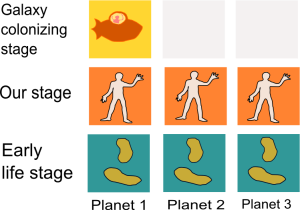SIA doomsday: The filter is ahead
post by KatjaGrace · 2010-03-22T15:16:48.000Z · LW · GW · 0 commentsContents
No comments
The great filter, as described by Robin Hanson:
Humanity seems to have a bright future, i.e., a non-trivial chance of expanding to fill the universe with lasting life. But the fact that space near us seems dead now tells us that any given piece of dead matter faces an astronomically low chance of begating such a future. There thus exists a great filter between death and expanding lasting life, and humanity faces the ominous question: how far along this filter are we?
I will argue that we are not far along at all. Even if the steps of the filter we have already passed look about as hard as those ahead of us, most of the filter is probably ahead. Our bright future is an illusion; we await filtering. This is the implication of applying the self indication assumption (SIA) to the great filter scenario, so before I explain the argument, let me briefly explain SIA.
SIA says that if you are wondering which world you are in, rather than just wondering which world exists, you should update on your own existence by weighting possible worlds as more likely the more observers they contain. For instance if you were born of an experiment where the flip of a fair coin determined whether one (tails) or two (heads) people were created, and all you know is that and that you exist, SIA says heads was twice as likely as tails. This is contentious; many people think in such a situation you should think heads and tails equally likely. A popular result of SIA is that it perfectly protects us from the doomsday argument. So now I’ll show you we are doomed anyway with SIA.
Consider the diagrams below. The first one is just an example with one possible world so you can see clearly what all the boxes mean in the second diagram which compares worlds. In a possible world there are three planets and three stages of life. Each planet starts at the bottom and moves up, usually until it reaches the filter. This is where most of the planets become dead, signified by grey boxes. In the example diagram the filter is after our stage. The small number of planets and stages and the concentration of the filter is for simplicity; in reality the filter needn’t be only one unlikely step, and there are many planets and many phases of existence between dead matter and galaxy colonizing civilization. None of these things are important to this argument.
.

.
The second diagram shows three possible worlds where the filter is in different places. In every case one planet reaches the last stage in this model – this is to signify a small chance of reaching the last step, because we don’t see anyone out there, but have no reason to think it impossible. In the diagram, we are in the middle stage, earthbound technological civilization say. Assume the various places we think the filter could be are equally likely..
.
This is how to reason about your location using SIA:
- The three worlds begin equally likely.
- Update on your own existence using SIA by multiplying the likelihood of worlds by their their population. Now the likelihood ratio of the worlds is 3:5:7
- Update on knowing you are in the middle stage. New likelihood ratio: 1:1:3. Of course if we began with an accurate number of planets in each possible world, the 3 would be humungous and we would be much more likely in an unfiltered world.
Therefore we are much more likely to be in worlds where the filter is ahead than behind.
—-
Added: I wrote a thesis on this too.
0 comments
Comments sorted by top scores.
